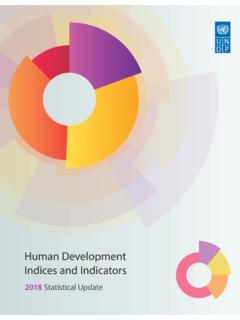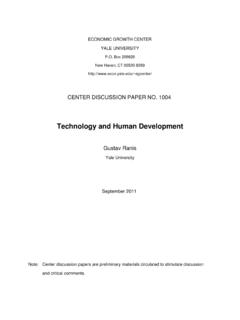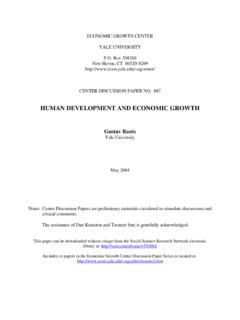Transcription of Women’s Growth and Development Across the Life Span
1 21 Clinical textbooks typically describe what is considered normal Growth and Development ; this description frames the upcoming chapters of this textbook s discussion of variations from what is considered normative. Although this approach may seem comprehensive, the dilemma is that the initial discussion of women s Growth and Development is often from a biomedical perspective. This representation deconstructs women s bodies into biologic parts and physiologic processes. While such an approach enables quantification of Growth , it is known that qualitative aspects of women s lives also influence their biomedical model of health is individualist and disease oriented.
2 In Chapter 1, this model is contrasted with a feminist and social model of health. The latter model acknowl-edges the influence of the culture in which women live, their economic status, the social interactions they experience, and the context in which they access and receive health care. The feminist model acknowledges the many other factors beyond the physiologic func-tioning of women and the genetic inheritance that affect their Growth and Development . As a result, even the manner in which we understand and explain what normative Growth and Development includes changes in the expanded framework of a feminist perspective, thereby allowing for a clearer understanding of the complexity inherent in women s Growth and a first step in considering women s Development (cognitive, psychosocial, and func-tional behaviors), it is important to acknowledge that the traditional models that are used were developed from research about men.
3 For example, psychoanalyst Erick Erikson (1950) expanded developmental theory beyond the years of adolescence to offer a grand theory of human Development (Table 2-1). He identified eight general stages of Development that included several within adulthood. The eight virtues that are the goals of the stages are trust, autonomy, initiative, industry, identity, intimacy, generativity, and integrity. ChapterWomen s Growth and Development Across the life SpanKerri Durnell Schuiling Lisa Kane 219/6/11 1:12:26 PM Jones & Bartlett Learning, LLC.
4 NOT FOR SALE OR DISTRIBUTION. Jones & Bartlett Learning, LLCNOT FOR SALE OR DISTRIBUTION Jones & Bartlett Learning, LLCNOT FOR SALE OR DISTRIBUTION Jones & Bartlett Learning, LLCNOT FOR SALE OR DISTRIBUTION Jones & Bartlett Learning, LLCNOT FOR SALE OR DISTRIBUTION Jones & Bartlett Learning, LLCNOT FOR SALE OR DISTRIBUTION Jones & Bartlett Learning, LLCNOT FOR SALE OR DISTRIBUTION Jones & Bartlett Learning, LLCNOT FOR SALE OR DISTRIBUTION Jones & Bartlett Learning, LLCNOT FOR SALE OR DISTRIBUTION Jones & Bartlett Learning, LLCNOT FOR SALE OR DISTRIBUTION Jones & Bartlett Learning, LLCNOT FOR SALE OR DISTRIBUTION Jones & Bartlett Learning, LLCNOT FOR SALE OR DISTRIBUTION Jones & Bartlett Learning, LLCNOT FOR SALE OR DISTRIBUTION Jones & Bartlett Learning, LLCNOT FOR SALE OR DISTRIBUTION Jones & Bartlett Learning, LLCNOT FOR SALE OR DISTRIBUTION Jones & Bartlett Learning, LLCNOT FOR SALE OR DISTRIBUTION Jones & Bartlett Learning.
5 LLCNOT FOR SALE OR DISTRIBUTION Jones & Bartlett Learning, LLCNOT FOR SALE OR DISTRIBUTION Jones & Bartlett Learning, LLCNOT FOR SALE OR DISTRIBUTION Jones & Bartlett Learning, LLCNOT FOR SALE OR DISTRIBUTION Jones & Bartlett Learning, LLCNOT FOR SALE OR DISTRIBUTIONT able 2-1 Erikson s Eigenetic Modelage Period for CrisisStages12345678 Infancytrust vs. Mistrustearly childhoodautonomy vs. Shame and Doubtplay ageInitiative vs. GuiltSchool ageIndustry vs. InferiorityadolescenceIdentity vs. Identity DiffusionYoung adultIntimacy vs.
6 IsolationadulthoodGenerativity vs. Self-absorptionMature ageIntegrity vs. DespairSource: Low, 229/6/11 1:12:26 PM Jones & Bartlett Learning, LLC. NOT FOR SALE OR DISTRIBUTION. Jones & Bartlett Learning, LLCNOT FOR SALE OR DISTRIBUTION Jones & Bartlett Learning, LLCNOT FOR SALE OR DISTRIBUTION Jones & Bartlett Learning, LLCNOT FOR SALE OR DISTRIBUTION Jones & Bartlett Learning, LLCNOT FOR SALE OR DISTRIBUTION Jones & Bartlett Learning, LLCNOT FOR SALE OR DISTRIBUTION Jones & Bartlett Learning, LLCNOT FOR SALE OR DISTRIBUTION Jones & Bartlett Learning, LLCNOT FOR SALE OR DISTRIBUTION Jones & Bartlett Learning.
7 LLCNOT FOR SALE OR DISTRIBUTION Jones & Bartlett Learning, LLCNOT FOR SALE OR DISTRIBUTION Jones & Bartlett Learning, LLCNOT FOR SALE OR DISTRIBUTION Jones & Bartlett Learning, LLCNOT FOR SALE OR DISTRIBUTION Jones & Bartlett Learning, LLCNOT FOR SALE OR DISTRIBUTION Jones & Bartlett Learning, LLCNOT FOR SALE OR DISTRIBUTION Jones & Bartlett Learning, LLCNOT FOR SALE OR DISTRIBUTION Jones & Bartlett Learning, LLCNOT FOR SALE OR DISTRIBUTION Jones & Bartlett Learning, LLCNOT FOR SALE OR DISTRIBUTION Jones & Bartlett Learning, LLCNOT FOR SALE OR DISTRIBUTION Jones & Bartlett Learning, LLCNOT FOR SALE OR DISTRIBUTION Jones & Bartlett Learning, LLCNOT FOR SALE OR DISTRIBUTION Jones & Bartlett Learning, LLCNOT FOR SALE OR DISTRIBUTION Women s Growth and Development Across the life Span 23 Through a process of resolving eight developmental crises that are sequentially con-fronted.
8 Erikson s theory offers a comprehensive account of individual Development through-out the life span that until recently was applied to both males and females. It is important to understand that Erikson s stages of psychosocial Development are based on studies of white, middle-class males (Erikson, 1968) and yet the model is universally applied to women with some gendered assumptions. The underlying gendered assumptions within Erickson s grand theory of Development must be recognized because within this theory individuals are treated as a monolith, with minimal attention being paid to gender, socioeconomic, or ethnic variability (Gilligan, 1982; Taylor, 1994).
9 Some of the gender-based assumptions include a normative linear pattern of identity, followed by marriage (intimacy), and then childbearing (generativity) in adulthood. Erikson s theory assumes the need for a female to first develop an intimate relationship with another before she can complete her sense of self as an individual. Interestingly, males (according to this theory) do not have the same requirement. Thus, while the larger context of the theory assumes the desirability of autonomy and distancing oneself from the family of origin, for females autonomy is defined as being dependent on another within the context of a relationship, with a primary focus on caretaking by examples of grand theories that are misapplied to women include those developed by Kohlberg (1981) and Perry (1968).
10 Kohlberg s levels of moral Development are based on interviews with only men, and Perry actually discarded interviews he had with women, using only data from interviews with men to formulate his model of intellectual Development . The difficulty that occurs when these scales are used to assess a woman s developmental level is that they assume universality in Development and, again, treat all women as a monolith, not acknowledging the multiple variables that can affect progress through the stages (Belenky, Clinchy, Goldberger, & Tarule, 1986; Low, 2001).













